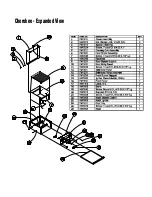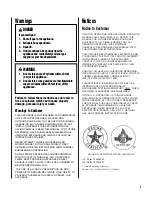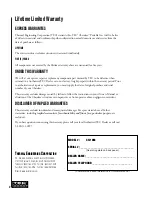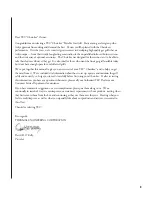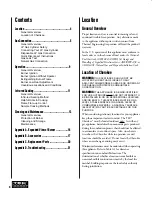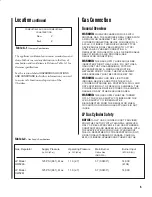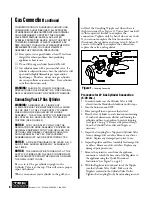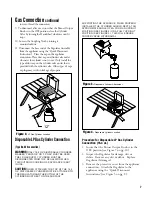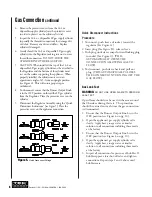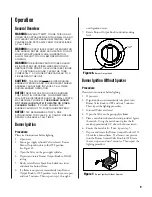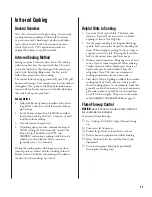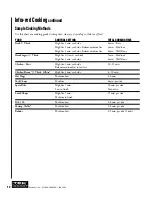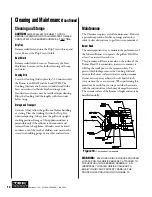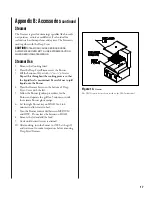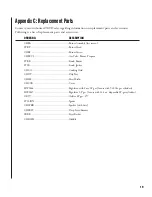
13
General Overview
Proper care, maintenance and cleaning will help ensure
long life of your grill. Periodic cleaning will help avoid
accumulations of flammable grease, fats, and other
debris.
Because of the high intensity of the Infra-red Burner, any
drippings and food particles that fall onto the Burner
surface are immediately incinerated. However, some
debris and residue may remain. To remove this residue
after cooking, turn the grill on HIGH for 5-10 minutes
with the cover OPEN. This is referred to as the “BURN
OFF” phase.
Protection of Burner
The Burner of your grill is designed to provide a long life
of satisfactory performance. However, there are steps you
must take to prevent cracking of the Burner’s ceramic
surface, which will cause the Burner to malfunction.
Following are the most common causes of cracks and the
steps you must take to avoid them.
Damage caused by
failure to follow these steps is not covered by your grill
warranty.
IMPACT WITH HARD OBJECTS -
Never allow hard objects
to strike the ceramic. You should take particular care
when inserting or removing Cooking Grid and
accessories into or from the grill. If objects such as these
fall onto the ceramic, it is likely to crack the ceramic.
IMPAIRED VENTILATION OF HOT AIR FROM GRILL -
In order
for the Burner to function properly, hot air created by the
Burner must have a way to escape the grill. If the hot air
is not allowed to escape, the Burner may become
deprived of oxygen, causing them to backfire, especially if
the Burner output is set at HIGH. If this occurs
repeatedly, the ceramic may crack. This is the reason your
grill was designed with ventilation louvers, and the
accessories were designed to leave open space at the grill
surface. These design features give the hot air an escape
route. Accordingly, never operate your grill with very
little or no open space at the cooking surface (the
Cooking Grid provide sufficient open space).
Also, never cover the ventilation louvers with foil or other
materials that prevent air flow. Specifically:
■
Do not cover the entire surface with foil, a large pan,
etc.
WATER OR OTHER LIQUIDS -
When the burner are in
operation, their intense heat is normally sufficient to
vaporize any drippings, marinades or sauces that contact
the surface as a by-product of grilling. This does not
include water thrown into the grill to douse a flame.
Cold liquid contacting a hot surface in substantial
amounts can cause the surface to break. Also, if the
ceramic or interior of a Burner becomes wet while not in
use, later operation of the Burner can create steam, which
may produce enough pressure to crack the ceramic. In
addition, repeated soaking of the ceramic will cause it to
swell and expand. This expansion will create pressure on
the ceramic and cause it to crack and crumble.
■
Never douse water into the grill to control a flare-up.
■
Never expose the Burners to the risk of soaking by
rainfall, sprinklers or otherwise. Further, do not
attempt to operate your grill in the open air while it
is raining. Finally, after you use the grill, close the
cover as soon as you turn the burners OFF so that, if
it rains, the Burner will not be exposed to direct
rainfall.
■
If you find standing water in your grill (because of
exposure to rainfall, etc.), examine the ceramic
burner surface for evidence of possible water soaking.
If the ceramic appears to be wet, remove the Burner
from the grill and turn them upside down to empty
any water from the Burner body. After draining all
the water, place the Burner indoors and allow it to
dry thoroughly. Also, empty any water standing in
the grill’s Drip Tray. Then, reinstall the Burner. After
testing for gas leaks around all fittings as described in
the section entitled
GAS LEAK TEST
on page 9, you
should be able to resume normal use of your grill.
For further Burner maintenance instructions, see
MAINTENANCE
section
.
Cleaning and Maintenance
Summary of Contents for Cherokee CH-10SS
Page 2: ...Cherokee Expanded View...


